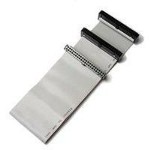
Disk Drives
Hard Disk Drives
 |
Inside a hard disk drive |
The two main types of drives in a computer system are the hard disk drive on which all your data is stored and programs are installed and the floppy disk drive where you can save data and programs although not very much.
Inside a typical hard drive is shown on the right. Data is sent through the read/write head and written on to the disk.
Hard disk drives can store a lot of stuff. They go up to capacities of 500 Gigabytes or more which is a lot of space. (Please see the technical page for more information on capacities accessed through clicking on the information link at the top of the page)
When you first start your computer (if you haven't cghanged the boot up sequence), the computer first scans the floppy disk drive to see if there is a system disk in it, (operating systems came on floppy disks at one time, Windows 3.1 for Workgroups being a good example and Windows 95 another good example). If there isn't a floppy disk in it, the computer will turn to the hard disk drive and laod the operating system and all associated files and programs from it.
 |
IDE Cable |
 |
Serial ATA cable (SATA) |
The computer cannot operate without a hard disk drive and it is the quickest way of starting (booting) up a computer. A lot of hard disk drives are connected through Integrated Drive Electronics ( IDE )cables and connectors (shown right) but are being increasingly replaced by Serial ATA connectors (shown right).
SATA cables are far faster than the more traditional IDE cables for transfering data to and from hard disk drives and I would think that eventually, IDE would be a thing of the past but for now, I'm happy with it.
Floppy Disk Drives
 |
Floppy Disk Drive |
 |
Floppy Disk |
You can see an example of a floppy drive on the right along with an example of a floppy disk. Te floppy disk drive is normally installed inside the system unit and you only usually see the front panel.
Now if you hold a floppy disk you find that it isn't at all floppy, it's a rigid plastic. Well that's just the case, the floppy disk is inside it and you wouldn't be able to insert the floppy disk as it is into the disk drive so it is out into a plastic case so that it can be used.
We don't see many floppy disks in use these days, mainly because the CD / CVD has suprceded it. That would be mostly because the floppy disk can only store up 1.44 Mb whereas the CD ROM can store up to 800 Mb (maybe even 900 Mb) of data and the DVD can store just over 4.5 Gb. Not just capacity but speed of reading and writing is a lot, lot faster than a floppy disk.
Looking at things from a storage of data point of view you can see why they are a lot less used. However, saying that, they still have thier uses and one use I find very handy is as a Windows 95 start-up disk.
What is a Windows 98 Start-up disk I hear you asking?
